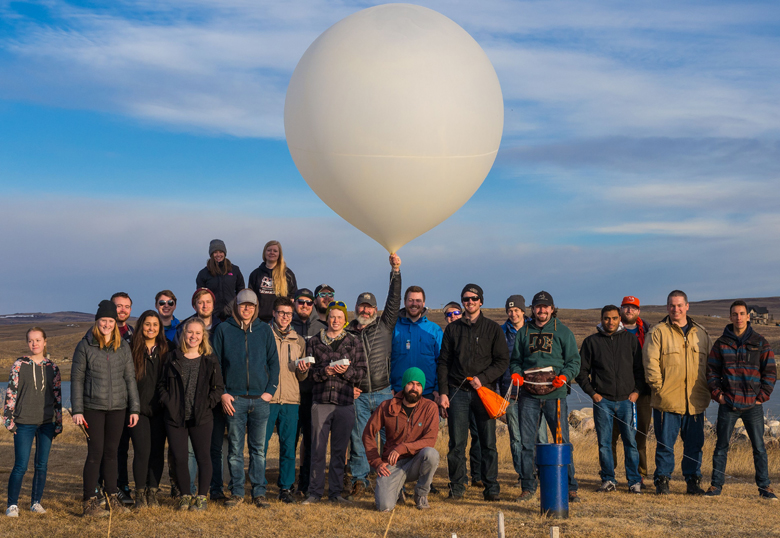When University of Lethbridge geography professor Dr. Craig Coburn looked at redesigning his Remote Sensing 4650 course, he aimed high – all the way to space. Proposing a high-altitude balloon project as the centerpiece, Coburn and his 24 students designed, created and launched a remote sensing system that scraped the edge of the earth’s upper atmosphere and provided an unparalleled student experience.
“I looked at the course and thought, why not. We can build a sensor, calibrate it, launch it, do the analysis all the way through to product generation in one class – if we do it right,” says Coburn.

Suddenly, a class that used to attract fewer than 10 students had to be cut off at 24. While videos exist showing American schools launching high altitude balloons, Coburn was much more ambitious with his plans.
“They’d never put up as advanced a system as we put up, but we’re supposed to be good at this, right? Remote sensing is a U of L thing so I thought, let’s try it,” says Coburn. “We had no idea if it would work or not.”
Buoyed by a $2,500 Teaching Innovation Fund from the U of L’s AGILITY program and the Teaching Centre, Coburn split his students into four groups tasked with various aspects of the project and the building began. The design of the instrument cluster was relatively simple, consisting of three cameras (colour, infra-red and thermal), GPS, temperature and pressure sensors, two Raspberry Pi mini computers and a GoPro action camera. This was all housed in a Styrofoam shell and mounted on a wood frame.
“It was not terribly complicated other than the imaging system, which was pretty fancy,” says Coburn. “In essence we were able to create five spectral bands, which is pretty good.”
With two tanks of helium to power its launch, the class set out for a site early one Saturday morning and set the balloon free on the outskirts of Stavely, Alta. Designed to scrape the upper limits of the atmosphere before bursting, the balloon exceeded expectations, eventually rising to 30,132 metres and traversing 160 kilometres before rupturing and floating on a parachute to the earth in a horse paddock near Brooks. All the while, the instrument cluster snapped photos and took measurements as it passed through the -65C temperatures of the troposphere and the thin air of the stratosphere.
Students followed its flight via GPS and, while tracking it on the ground, performed spectral measurements to ensure the accuracy of the data collected by the on-board imaging systems. They were then tasked to download and interpret the data once back in the lab.
“Maybe we didn’t learn all that much scientifically but at the end of the day, they now understand how it all works, from beginning to end,” says Coburn, who was assisted by balloon expert Nicholas Janzen of Calgary and recently graduated master’s student Gordon Logie, who snapped photos. “That’s something very few universities can offer. They created a system, launched a system and then were able to work with raw data they had to process. They also had to work with each other and off of each other, so we had physics students working with geography students and computer science students to make it all work.”
For fourth-year geography student Sarah McCrady, the experience was invaluable.
“I was part of one of the vicarious calibration groups, which involved getting ground spectral measurements,” she says. “I found the project really emphasized the importance of teamwork and the complexity that major projects like this entail. I had no idea how many things there were to consider, such as weather for launch, and legal permissions.”
Travis Houston is in his third year of geography with an interest in geographic information systems (GIS) and the intricacies of imaging.
“I got the chance to learn how satellite and aerial images are calibrated and adjusted post-launch, how to use the various instruments involved and how sensors react to reflected light from the Earth’s surface,” he says. “This experience definitely will help me in my career in that it gave me a clear understanding of what really makes up an image. Knowing how an image is taken and the effects that need to be accounted for is invaluable when using earth imagery for analytical purposes.”
Coburn now has a template for next year’s project, along with valuable lessons learned for another launch.
“You don’t always get this level of experience, where you have 20 students in a fourth-year class doing something cool – which is what I was after,” he says, crediting the AGILITY program’s support for making the project possible. “You want them excited by the opportunity and this is something we could offer that you can’t do anywhere else. With the knowledge we gained from this experience, I’m already thinking of ways to tweak it for the next time.”

